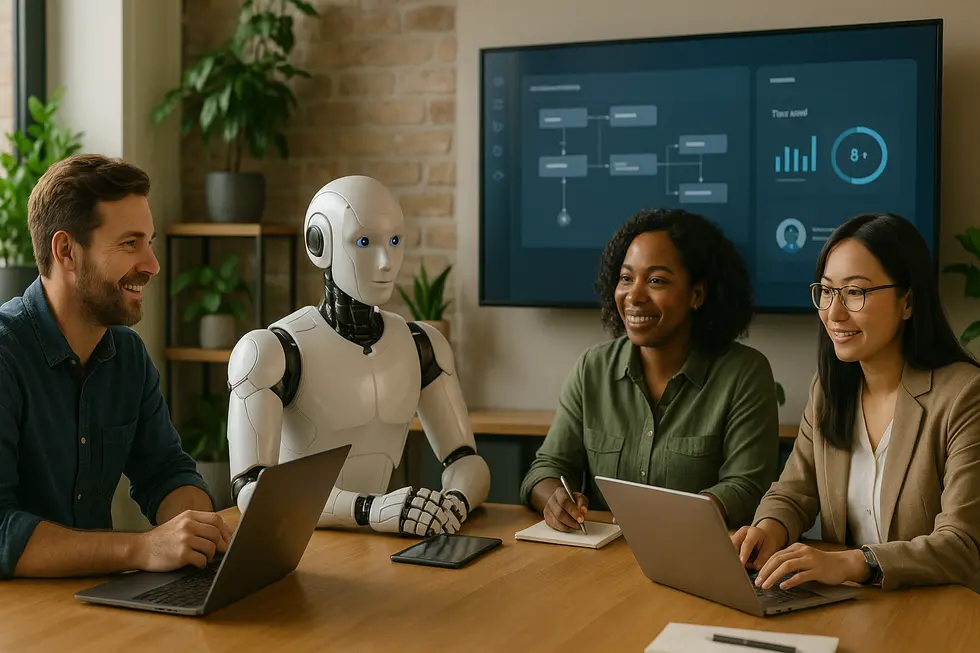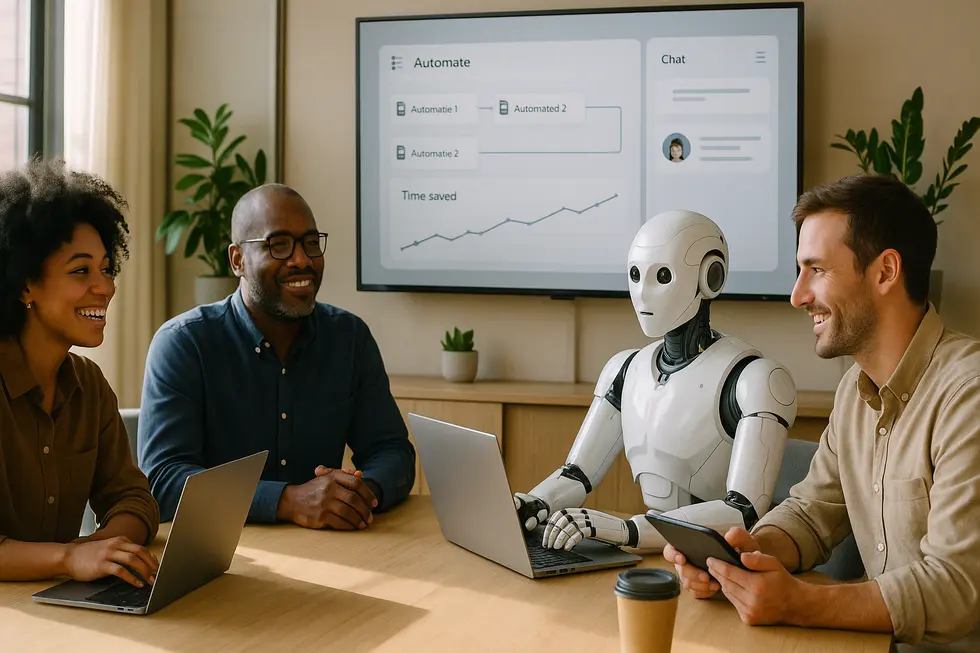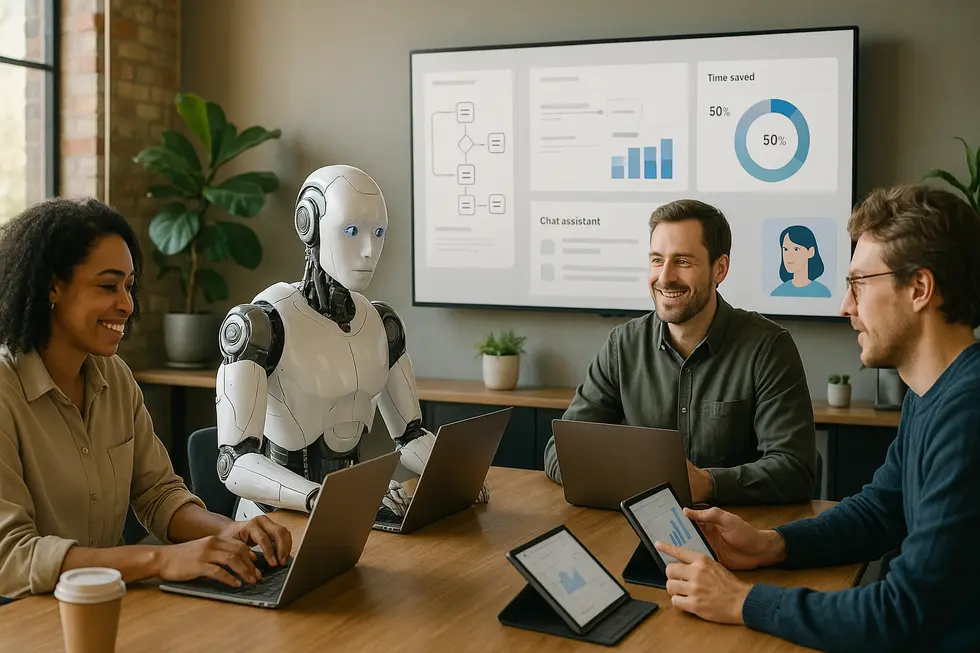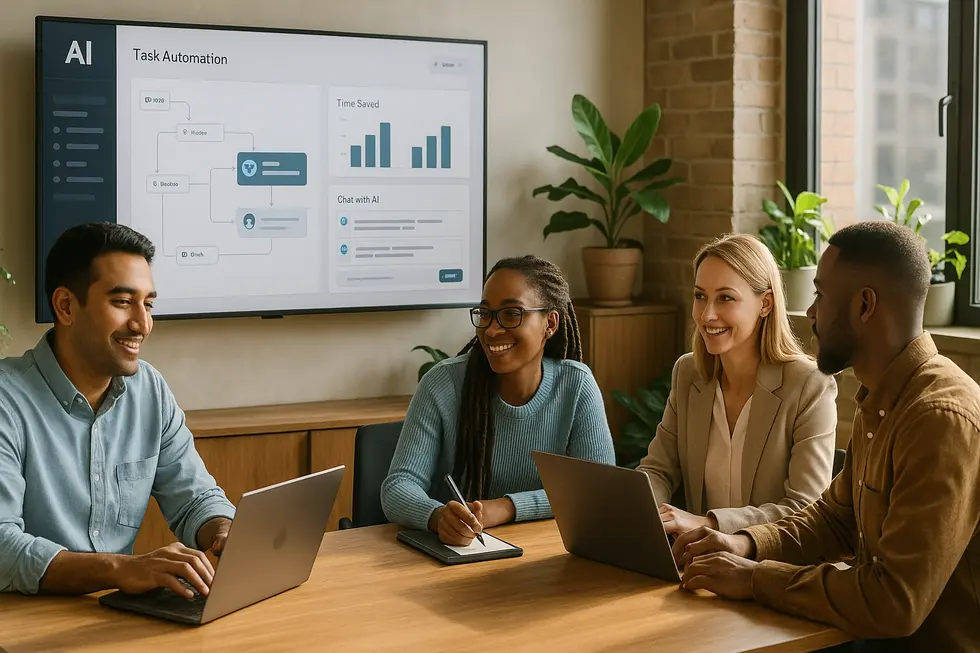Embedding AI as a Collaborator: How Workflow Augmentation Turns Tools into Teammates

AI as a collaborator reshapes work by augmenting human skills and improving everyday workflows. When organizations treat AI like a team member, they change how tasks move through the business. Routine, repetitive work is delegated to systems that learn, adapt, and surface useful insights. This frees people to focus on strategic thinking, creative problem solving, and relationship building.
Rather than replacing roles, AI fills gaps in capacity and consistency. Consider a bank that equips developers with intelligent assistants. Those assistants speed coding, catch simple errors, and suggest patterns, so engineers spend more time on architecture and innovation. Or picture an online retailer with an autonomous agent that drafts help articles and replies with contextual answers. Customer issues are resolved faster, and human agents handle edge cases and complex escalation. In both scenarios AI increases output and reduces friction without eliminating the human element.
Workflow augmentation also means connecting steps that once required manual handoffs. AI can extract structured data from messy documents, populate systems, and trigger multi-step processes across departments. This reduces error rates and shortens cycle times. Analytics embedded in those flows surface trends that influence hiring, scheduling, and resource planning. Decisions become more evidence-based, and teams act on timely signals instead of hindsight.
Creative teams benefit too. AI can generate first drafts, propose visual variations, and automate basic edits. That accelerates testing and iteration, so teams can run more experiments and learn faster. Crucially, humans retain final judgment. Editors refine tone, strategists set direction, and specialists ensure outputs meet ethical and quality standards. Keeping people in the loop makes AI useful and trustworthy.
Treating AI as a teammate also alters management practices. Leaders focus on orchestration, not command and control. They design roles that pair human strengths with AI capabilities. Training shifts from rote tasks to critical thinking and AI supervision. This produces higher job satisfaction, because employees spend time on meaningful work rather than repetitive chores.
Adopting AI as a collaborator is a strategic move. It unlocks scalable performance and smarter decision-making, while preserving human judgment. Teams become both faster and more innovative when systems handle predictable work and people handle nuance. For a concrete look at AI applied to HR workflows, see this industry writeup: https://www.teamsense.com/blog/companies-using-ai-in-hr. For guidance on growing capacity without linear hiring, explore scaling without hiring: https://vaiaverse.com/vaiaverse-blog/scaling-without-hiring/.
AI as a Colleague: How Efficiency, Cost Cuts, and Productivity Fuel Business Advantage

AI as a Colleague transforms economic outcomes by shifting effort to higher value work. When organizations treat AI like a dependable teammate, routine tasks move off human desks and into automated workflows. That shift shortens cycle times, lowers error rates, and lets employees focus on judgment, relationship building, and creative problem solving. Practical gains show up in many places: faster task completion, smoother scheduling, and fewer manual reconciliations that previously ate into daily capacity.
The economic logic is simple and powerful. Repetitive processes often consume the majority of employee time. By automating those processes, companies reclaim hours and repurpose them for strategic priorities. That reallocation both increases throughput and improves employee engagement. Teams finish work faster, managers see clearer capacity, and leaders can redeploy staff to initiatives that drive revenue or customer value. The result is measurable productivity gains alongside reduced operational headcount pressure.
Treating AI as a team member also changes how companies scale. Instead of relying solely on hiring to grow capacity, companies can scale operations by combining human skills with AI capabilities. This approach reduces per-unit labor costs and shortens the time to reach new outcomes. It supports sustainable growth strategies where investment targets technology and capability building rather than only expanding payroll. For a closer look at this idea, see the post about scaling without hiring: scaling without hiring.
Economic impact goes beyond immediate time savings. AI-driven analytics inform better decisions about hiring, workforce planning, and compensation. Predictive insights expose bottlenecks and recommend precise interventions, which reduces wasteful spending. Personalized learning recommendations close skill gaps faster, improving retention and lowering hiring churn. Over time, these effects compound into stronger margins and clearer competitive advantage.
There are implementation realities to accept. Initial deployment can create short-term disruption and require investment in training, integration, and governance. The payoff arrives when companies set measurable goals and build an AI skills strategy. With clear metrics and accountability, AI becomes an amplifier of human work rather than a disruptive replacement. Leaders who adopt this collaborative stance unlock ROI while preserving critical human judgment.
Viewed holistically, treating AI like a teammate is an economic strategy. It reduces routine costs, raises productive output, and enables smarter growth. Companies that align technology, process, and people get the most durable gains, turning AI from an experimental line item into a dependable member of the workforce. For applied examples in HR and operations, see this overview of companies using AI in people functions: https://www.teamsense.com/blog/companies-using-ai-in-hr
Partnering with Intelligence: How Treating AI as a Team Member Elevates People and Performance

Smart companies that treat AI like a colleague change how work gets done. They design workflows where AI handles repetitive, data-heavy tasks while humans retain control over strategy, creativity, and ethics. This balance frees employees from tedious chores and restores time for high-value work that machines cannot do. The result is higher productivity, less burnout, and a stronger sense of purpose across teams.
When AI is positioned as a collaborator, it is integrated into daily routines rather than bolted on as a separate tool. Automated scheduling, payroll checks, and compliance monitoring reduce friction in operations. At the same time, AI-driven analytics surface hiring patterns, compensation gaps, and workforce trends that inform better decisions. Those insights do not replace human judgment; they sharpen it. Human teams interpret signals, weigh context, and make choices that reflect values and long-term goals.
Treating AI like a team member also reshapes employee experience. People feel more supported when AI responds instantly to benefits questions or personalizes onboarding and learning paths. That responsiveness fosters belonging and motivation. When AI reliably manages routine issues, HR and managers can focus on mentoring, coaching, and ethical stewardship. Employees then spend more time on work that strengthens identity and mastery, which improves retention and engagement.
This human-centric framing demands clear governance. Smart organizations keep humans in the loop to ensure fairness and accountability. They set boundaries for autonomous actions, define when escalation is required, and enforce transparent audit trails. Ethical oversight prevents blind reliance on algorithmic outputs, and deliberate feedback loops let teams refine models based on real workplace nuance.
Innovation accelerates when humans are liberated from monotony. Teams experiment, ideate, and iterate faster because cognitive bandwidth increases. AI can predict and resolve routine incidents proactively, reducing downtime and stress. Yet the most valuable breakthroughs still come from human creativity, empathy, and contextual judgment. The best outcomes appear when AI amplifies these human strengths, not when it tries to emulate them.
Across industries, the payoff is tangible: more accurate decisions, smoother operations, and richer employee relationships. Leaders who treat AI as a partner build systems that amplify team potential without sacrificing human agency. That shift creates workplaces where technology is not a threat but a dependable teammate, enabling employees to do their most meaningful work. For practical examples of AI applied in HR workflows, see this analysis of how companies are using AI in HR: https://www.teamsense.com/blog/companies-using-ai-in-hr
For guidance on adopting a collaborative AI mindset, consider how incremental automation, ethical guardrails, and personalized employee experiences can be piloted together. Also explore perspectives on making AI the new standard without fear via this internal piece: AI new standard, no fear.
Final thoughts
Treating AI like a team member is a practical strategy for small and medium businesses that want to boost efficiency, reduce costs, and improve employee experience without sacrificing human judgment. Start by integrating AI into well-defined, high-volume processes, measure outcomes, and keep people responsible for decisions that matter. When you pair AI capabilities with strong governance and transparent collaboration, the technology becomes a multiplier for human talent rather than a threat. The most successful SMBs will be those that adopt AI incrementally, measure impact, and invest savings back into people and processes so gains compound over time.
Ready to transform your business with real AI employees? Let vaiaverse automate your sales, support, and lead generation with powerful AI Agents – fully operational across phone, email, WhatsApp, and more. Talk to our team and discover how smart your business could run.
About us
Vaiaverse builds practical AI Agents that operate like reliable team members across channels small and medium businesses use every day. Our platform deploys AI-driven agents for sales outreach, customer support, lead qualification, appointment setting, and benefits assistance, integrated with phone, email, WhatsApp, and major CRMs. We focus on measurable outcomes: reducing repetitive work, improving response times, and increasing conversion while keeping humans in control. Vaiaverse handles data connectors, compliance defaults, and ongoing tuning so leaders can pilot quickly and scale confidently. We also provide governance tooling and training to ensure ethical use and a smooth human-AI collaboration experience.









